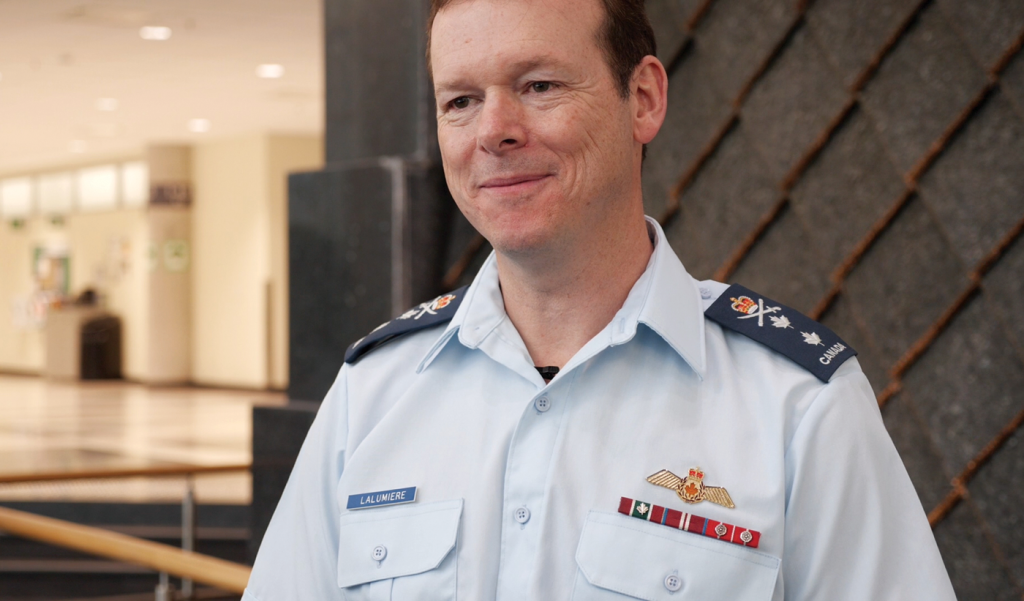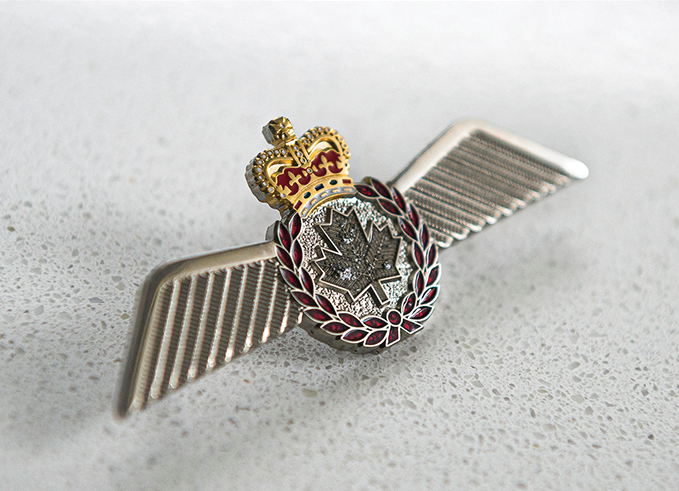The future of the Air Force is built upon the service and sacrifices of the past
By Lookout on May 03, 2021 with Comments 2
Captain Sarah Harasymchuk and
Lieutenant (Navy) Melanie Aqiqi
––
It was a grim day nearly eight decades ago when 426 Bomber Squadron, known as the Thunderbirds, received a new mission order.
They were tasked with bombing the railyards at Louvain, Belgium, as part of a 120 aircraft raid on May 13, 1944, during the Second World War. There were 14 Thunderbirds on the battle order, carrying nine 1,000-pound bombs and four 500-pound bombs.
The eight-person crew on board Halifax LW682/OW-M never reached their objective.
Instead, they were shot down by a Luftwaffe night-fighter ace, Hauptmann Martin Drewes of III / NJG1. They crashed into a bog near the River Dender at Schendelbeke and all eight crew members were killed. The muddy terrain quickly engulfed the aircraft with three crew members still inside.
When the Halifax Bomber was finally recovered in 1997 by a Canadian-led excavation team, the recovered aluminum took on new meaning for the Royal Canadian Air Force (RCAF) and its members. Metal recovered from the crash site was melted down into ingots. Fragments of that metal are being incorporated into the enamels of new metal flying badges and serve as a visible reminder of past sacrifices.
“The designs of the full-wing and upswept wing metal flying badges, worn on the summer dress uniforms of qualified aircrew, were modernized under the Flying and Occupation Badge Update Project. Aluminum grindings, obtained from the ingots of LW682 metal, are incorporated into the clear enamels used in some of the badges and in the red enamels used in the laurel wreaths of all of the badges,” says Major John Meurling, the Project Director.
Major-General Michel Lalumiere, Chief of Fighter Capability, says the new metal wings symbolize the crucial history of the sacrifices made by the pioneers of today’s modern Air Force.
“What is being carried through in the new design is the 95 years of history the RCAF has from its birth in 1924, but also its roots in the Royal Flying Corps and Royal Air Force where some Canadians started flying in World War One.”
It took 53 years before the Halifax LW682/OW-M and the final three crew members were fully recovered. The crew members were Pilot Officer W.B. Bentz; Flying Officer T.W. Taylor; Flying Officer C.S. Phillips; Pilot Officer J.E. McIntyre; Sergeant R. Ellerslie (RAF); Pilot Officer J.E.J.G. Arbour; Pilot Officer F. Roach; and Pilot Officer J.W. Summerhayes. In July 1948, the crew posthumously received the Belgian Croix de Guerre with Palm.
The new full-wing metal badges, rendered in a silver finish, will replace the current gold-coloured wings. The badges produced so far include Astronaut; Pilot; Air Combat Systems Officer; Flight Engineer; Airborne Electronic Sensor Operator; Search and Rescue Technician; and Loadmaster.
Production of the remaining flying badges will be completed later this year.
MGen Lalumiere says members wear their badges above the heart as a source of courage and moral compass.
“Those that made the ultimate sacrifice before us we reflect on in our history, and often we seek those examples when we are facing some of the challenges today. We source our courage, our dedication, our energy in those examples from the past.”
The Halifax LW682 aluminum ingots were smelted from the wreckage of the aircraft and used to create several memorials: the roof of the Bomber Command Memorial in London’s Green Park, a memorial wall with engraved aluminum ingots at the Wing Commander Sedley S. Blanchard Air Mobility Training Centre, and the base of the Thunderbirds’ totem pole at the Air Mobility Training Centre in Trenton. Parts of the Halifax LW682/OW-M were also used in the restoration of a Halifax NA337 in Trenton.
The largest Canadian contribution and sacrifice during the Second World War was the RCAF’s participation in the Royal Air Force Bomber Command. More than 10,000 RCAF aircrew were killed, and thousands were injured or taken prisoner of war while serving in Bomber Command, which was the most dangerous role for the Allied forces. Their legacy is honoured and cherished as part of these new metal flying badges.
––
Filed Under: Top Stories
About the Author:








You should rewrite your article and include the organizations that contributed in this project.
The RCAF must correct the story behind this beautiful project.
Merci
Gilles
I am the Chaplain at the Canadian Warplane Heritage Museum as well as a member of The RCAF Association. My father and uncle both served in the Second World War. I also have visited and follow the Bomber Command Museum of Canada. I feel that contribution of that Museum should be acknowledged in the recovery of the Hercules Aircraft as well as providing the ingots for the RCAF Flying Badges. If it weren’t for these volunteer organizations, our country would be poorer.
Thank you for your consideration,
Rev Douglas Mitchell